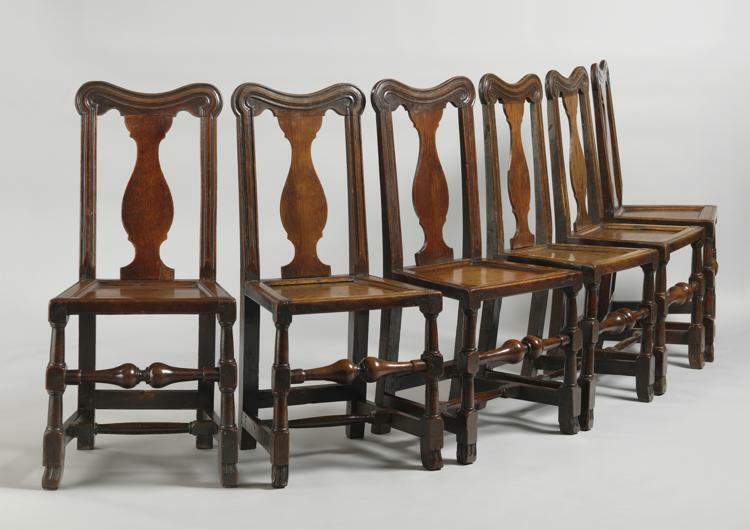A CLOSER LOOK

"What’s the Score?"
Genuine Matching Set of Six Queen Anne Period Dining Chairs.
When people visit us here in Battersea, they frequently like to touch and handle the pieces we have on exhibition, but also enjoy discussing the pieces that attract them.
I find myself in much the same position when in independent wine shops, where I love to chat and learn from specialist merchants who know the vineyards and wine makers. I enjoy their knowledge and understanding of the “terroir”, the climate of the vintages and its effect on the flavour or body of the wine, the grape varieties and blends. I learn more about the wine from them than I ever could just from a label and it often greatly increases the pleasure when tasting or drinking it.
There is a similarity in the art and antiques world, for example I never used to listen to the audio tapes at museum shows and exhibitions, but now find that there can be elements of the informed narrative that enhance my experience and help me see, understand or look at works in a new or different way.
A long standing client and regular visitor to our shop, recently suggested that it would be interesting to read our comments about the pieces we have, in much the same way as we would chat about them here, so we have decided to start posting some notes, here on our online Journal, under the heading “A Closer Look” and plan to do it regularly, if the initiative generally meets with your interest. So any feedback will be gratefully received.
Last week we looked at a Georgian period vernacular table and I thought it appropriate to now look at some early chairs.
Many early furniture enthusiasts have a real soft spot for chairs and I think this is possibly because unique individual characteristics are often most evident in them. Chairs and stools probably have the hardest life and get the most wear of all the furniture forms. They are handled, moved, dragged, tilted and lent back on in a way that case and occasional furniture are not normally been subjected to. This tough life can lend great surface, patina and sculptural individuality to them, but also inevitably genuine old chairs may bear scars and bruises, some will have suffered structural damage, so they all warrant a closer look, as originality and condition are significant qualities to consider when considering all vernacular furniture.
The things to look out for particularly are a loss of height or subsequently built-up / restored feet; loose joints to joined frame constructed chairs; broken or loose spindles, socketed arm or upper bow joints in Windsor style chairs; damaged or replaced stretchers and shrinkage splits to solid seats. Once a chair has begun to get wobbly or loose it tends to rapidly deteriorate and the subsequent necessity for restoration becomes more involved and complicated the longer it is left unattended to.
So with this in mind, it is easy to understand how unusual and exciting it is to find a genuine matching set of chairs that are now just over 300 years old, still in original, strong and functional condition!
The design of these chairs is a kind of hybrid combining elements of the late C17th William and Mary style, as evidenced in the turned leg joined frames, “Braganza” feet , framed and panelled seats and the slightly more refined and elegant Queen Anne period details of the classical baluster splats and double domed crest rails.
However the most immediately noticeable feature are the wonderfully bold, turned central stretchers, which with their horizontal three dimensional form are compatible with and complimentary to the flat graphically strong silhouettes of the vertical baluster splats above. The chairs are constructed from excellent quality oak and there would have been considerable wastage when turning these stretchers, to allow for their generous scale. Framed panelled seats are always a fine quality feature in C18th provincial chair making, and were introduced to allow for the natural shrinkage of the plank seats. The seat panels being set within the frame and never glued, pegged, nailed or fixed, allowing them to move freely without splitting.
Therefore we know that these chairs are fine examples, both from their style , material and construction, but what really makes them special is being a complete matching set, their originality, and most importantly their colour and surface.
These qualities are much sought after in all aspects of vernacular furniture and folk art. Great surface, both texture and colour are hard to define. It can be raw, bleached and weathered; crusty and rough with old remnants of historic paint or richly burnished, deeply patinated and “nutty”, but it always has to be real, un-interfered with and irresistibly tactile. We all somehow naturally recognize great surfaces when we see them and these chairs boast a wonderful “skin”, with the deep slightly red tone to the ancient oak timber, the surface well softened by years of handling and use, enhanced by historic oil and wax finishes, which have built up a lustrous polished surface.
Another visitor to the shop likes me to try and score items we have on a scale of 1-10, also much like wine writers do sometimes. This can be a testing process as we try only to source special or unusual examples and vernacular pieces tend to be unique, yet my analysis has to be reasoned, informed and comparative. So I have to consider to the reasons the piece excited me enough to buy it and then think back as to when and where I have seen comparable examples and how their features and qualities compare. Then I realised of course that subliminally I do the same thing every time I look at pieces and if the invisible score is high enough then we try and buy the piece in question.
I believe that the qualities that need to be considered to arrive at an overall score rating are as follows; Material/Medium, Period, Quality, Look, Scale, Style, Condition, Rarity, Character, Originality, Colour and Surface.
It is hard to bless something with a perfect 10/10 and I’ve often wondered how expert figure skating and diving judges are occasionally brave enough to do so, particularly when some of the elements they are scoring are so subjective. I am also an optimist and always hope that somewhere, sometime we will find something we consider better than anything we’ve seen before. But in the meantime and back to this set of chairs, I believe they meet the highest standard in the categories I mention above, but in order to leave the pleasure of one day discovering an even better original set, I’d theoretically score them at 9.7/10.
Also in Journal

Tom Hickman - "One Man and His Needle"
One Man and His Needle”, An extraordinary collection of recent and retrospective works by Tom Hickman, 6-16 December 2023.
"Following the success and the nationwide exposure he was subject to when winning the 2022 BBC Scotland’s “Home of the year”, I think it is fair to say that his status has changed."








